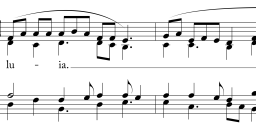Mode VIII Alleluia
-
For reason?
(Um, why are the notes round??) -
Ryan,
At the risk of starting a fire-bomb attack -- not from you but from others here -- can you explain why your harmonic underlay seems much more like a theory exercise than an accompaniment to voices? I've been complimented on my accompaniment of chant ordinaries, but I've never understood why what I do is so highly praiseworthy. I have, over the course of two decades, been struck by how common the "theory exercise" approach to accompanying chant is, and I don't know why it is so common. -
MJO:
1 - Because
2 - Because it's organ notation and not neumes? I don't really understand the question.
Chris:
I don't understand what you mean by theory exercise approach. I appreciate any input you have if you'd like to be more specific. -
If I didn't know there are no farmyards nearby I would swear I just heard a distant chant "Four corners good, no corners bad!"
-
I am so confused right now.
-
I've used this Alleluia in both OF and EF liturgies. It works well.
-
Congregations and choirs like their accompaniment to lead them where they're supposed to go -- which is why some guitar chord simplifications do such damage to musical line progressions: G major and E-minor aren't the same. I don't have time this nanosecond, but I'll try to give directly specific suggestions of how I might accompany the same chant, as soon as I can.
-
I think that as a good melody will generally illuminate a text, so should a good accompaniment illuminate the melody. Here's my shot at harmonizing this particular melody. Keeping in mind that chants typically move in melodic cells of "twos and threes," I tried to use chord progressions that, as CGZ said, would lead the melody forward, and without being clichéd, make the conclusion of the melody seem almost inevitable, given the linear and harmonic trajectory it was on.

 GregorianAlleluiaMode8.png5759 x 1225 - 164K
GregorianAlleluiaMode8.png5759 x 1225 - 164K -
Yours is a good lead for singers to follow. Mine is for an organist to follow a good schola's lead.Thanked by 1JonathanKK
-
Ryand,
That's the other shoe! Thanks for that.
God bless,
Chris -
Ooh, that's a great perspective. Perhaps, especially with chant, accompaniments ought to be fitted to the needs of the choir. That should apply equally to modern settings, maybe, thereby increasing the usefulness of a composer/arranger's work.
-
accompaniments ought to be fitted to the needs of the choir.
Hic. Semper et ubique.
Welcome to the MusicaSacra Forum!
To participate in the discussions on Catholic church music, sign in or register as a forum member, The forum is a project of the Church Music Association of America.
Categories
- All Discussions21,111
- General Music Discussion8,219
- Job Openings197
- Management of Music Programs850
- Choral Matters533
- Church Documents and Rubrics524
- CMAA Notes302
- Events716
- For Newcomers: Read First26
- Sacred Polyphony546
- Hymnody872
- Gregorian Chant: General2,698
- ↳ Graduale Romanum and Liber Usualis368
- ↳ Graduale Simplex60
- ↳ Semiology63
- Vernacular Plainsong696
- Anglican Use and Anglican Chant68
- Organ, Other Instruments and Repertoire435
- New Composition/Works in Progress1,291
- Recordings232
- Music for Hispanic Ministry159
- Music Education: Children211
- Music Education: General222
- News Items245
- Positions Wanted2
- General Discussion: Catholicism739
- Amusements177
- General Discussion1,034
- Opinions117





